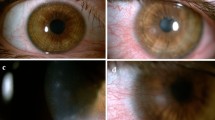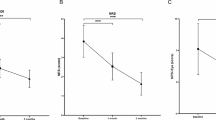Abstract
Introduction
This study was designed to compare the efficacy of cyclosporine ophthalmic emulsion 0.05% with an artificial tear solution for the treatment of rosacea-associated eyelid and corneal pathology.
Methods
Double-masked, randomized, 3-month clinical trial of 37 patients with rosacea-associated eyelid and corneal changes (defined as lid margin telangiectasia, meibomian gland inspissation, and/or fullness of the lid margin). All findings were standardized and compared to photographs for grading.
Results
There was a statistically significant increase in Schirmer (with anesthesia) scores of 2.7±2.2 mm after 3 months of treatment in the topical cyclosporine group (P<0.001), compared with a mean decrease of −1.4±4.6 mm (P=0.271) in the artificial tears group. The mean tear break-up time score significantly improved in the topical cyclosporine group (mean increase of 3.56±1.5 seconds, P<0.001), but worsened in the control group, although this change was not significantly significant (mean decrease of −0.04±1.6 seconds, P=0.929). The topical cyclosporine group exhibited a significantly greater mean reduction in corneal staining scores (−1.3±0.53) compared with the control group (−0.2±0.83; between groups P<0.001). The topical cyclosporine group had a greater improvement in Ocular Surface Disease Index scores than those using artificial tears (P=0.022). Limitations of the study included an older, predominantly Caucasian patient population and short trial length.
Conclusions
Topical cyclosporine 0.05% is more effective than artificial tears for the treatment of rosacea-associated lid and corneal changes.
Similar content being viewed by others
References
Ghanem VC, Mehra N, Wong S, Mannis MJ. The prevalence of ocular signs in acne rosacea: comparing patients from ophthalmology and dermatology clinics. Cornea. 2003;22:230–233.
Marmion VJ. Tetracyclines in the treatment of ocular rosacea. Proc R Soc Med. 1969;62:11–12.
Akpek EK, Merchant A, Pinar V, Foster CS. Ocular rosacea: patient characteristics and follow-up. Ophthalmology. 1997;104:1863–1867.
Bowman RW, McCulley JP, Jester JV. Meibomian gland dysfunction and rosacea. In: Pepose J, Holland G, Wilhelmus K, eds. Ocular Infection and Immunity. St. Louis: Mosby-Year Book; 1996:334–343.
Kocak-Altintas AG, Kocak-Midillioglu I, Gul U, et al. Impression cytology and ocular characteristics in ocular rosacea. Eur J Ophthalmol. 2003;13:351–359.
Barton K, Monroy DC, Nava A, Pflugfelder SC. Inflammatory cytokines in the tears of patients with ocular rosacea. Ophthalmology. 1997;104:1868–1874.
Bron AJ. Diagnosis of meibomian gland disease and MKC: what is really meant by meibomian inflammation? Am J Ophthalmol. 2005;139:S23–S24.
Macsai M. The role of Omega-3 dietary supplementation in blepharitis and meibomian gland dysfunction (an AOS thesis). Trans Am Ophthalmol Soc. 2008;106:336–356.
Jansen T, Plewig G. Rosacea: classification and treatment. J R Soc Med. 1997;90:144–150.
Wilken J, Dahl M, Detmar M, et al. Standard classification of rosacea: report of the National Rosacea Society Expert Committee on the classification and staging of rosacea. J Am Acad Dermatol. 2002;46:584–587.
Randleman JB, Loft E, Song CD. Ocular rosacea. Available at: http://www.emedicine.com/oph/topic115.htm. Accessed Nov. 7, 2006.
Donnenfeld E, Pflugfelder SC. Topical ophthalmic cyclosporine: Pharmacology and clinical uses. Surv Ophthalmol. 2009;54:321–338.
Sall K, Stevenson OD, Mundorf TK, Reis BL. Two multicenter, randomized studies of the efficacy and safety of cyclosporine ophthalmic emulsion in moderate to severe dry eye disease. Ophthalmology. 2000;107:631–963. Erratum in: Ophthalmology. 2000;107:1220.
Restasis [package insert]. CA: Allergan Inc.; 2004.
Kunert KS, Tisdale AS, Stern ME, et al. Analysis of topical cyclosporine treatment of patients with dry eye syndrome: effect on conjunctival lymphocytes. Arch Ophthalmol. 2000;118:1489–1496.
Doan S, Gabison E, Gatinel D, Duong M-H, Abitbol O, Hoang-Xuan T. Topical cyclosporine A in severe steroid-dependent childhood phlyctenular kerato-conjunctivitis. Am J Ophthalmol. 2006;141:62–66.
Schiffman RM, Christianson MD, Jacobsen G, et al. Reliability and validity of the Ocular Surface Disease Index. Arch Ophthalmol. 2000;118:615–621.
Bron AJ, Evans VE, Smith JA. Grading of corneal and conjunctival staining in the context of other dry eye tests. Cornea. 2003;22:640–650.
Driver PJ, Lemp MA. Meibomian gland dysfunction. Surv Ophthalmol. 1996;40:343–367.
Zengin N, Tol H, Gunduz K, et al. Meibomian gland dysfunction and tear film abnormalities in rosacea. Cornea. 1995;14:144–146.
Turner K, Pflugfelder SC, Ji Z, et al. Interleukin-6 levels in the conjunctival epithelium of patients with dry eye disease treated with cyclosporine ophthalmic emulsion. Cornea. 2000;19:492–496.
Perry HD, Wittpenn JR, D’Aversa G, Donnenfeld ED. Topical cyclosporine 0.05% for the treatment of chronic, active ocular rosacea. Poster presented at: Annual Meeting of the Association for Research in Vision and Ophthalmology; May 3, 2005; Ft. Lauderdale, Florida, USA.
Perry HD, Doshi-Carnevale S, Donnenfeld ED, et al. Efficacy of commercially available topical cyclosporine A 0.05% in the treatment of meibomian gland dysfunction. Cornea. 2006;25:171–175.
Author information
Authors and Affiliations
Corresponding author
Rights and permissions
About this article
Cite this article
Schechter, B.A., Katz, R.S. & Friedman, L.S. Efficacy of topical cyclosporine for the treatment of ocular rosacea. Adv Therapy 26, 651–659 (2009). https://doi.org/10.1007/s12325-009-0037-2
Received:
Published:
Issue Date:
DOI: https://doi.org/10.1007/s12325-009-0037-2




